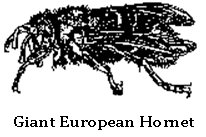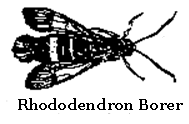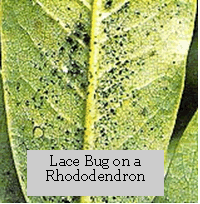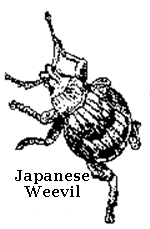The rhododendron is a commonly used landscape plant that has a specific complex of pests. Many of these insects also cause damage to azalea and mountain laurel. The discussion of the following insects will focus on recognition and life cycles, damage, monitoring and control options.
Azalea Bark Scale
(Erlococcus azalene)
Recognition and Life Cycle
Females are approximately 1/8-inch long and covered with a white, waxy egg sac. Eggs are laid in the spring and hatch from late-June to mid-July. These mobile immatures are known as "crawlers". The crawlers like to attach to the bark and feed in crevices and branch forks. This pest over-winters as a nymph (immature). There is one generation per year.
Damage
Scales insert their piercing-sucking mouthparts into the plant and feed on the juices. A large population will cause leaf discoloration, some dieback and an overall unthrifty plant appearance. These scales excrete a sticky, sweet liquid called "honeydew" which promotes the growth of black sooty mold fungus on contaminated surfaces.
Monitoring
Look for discoloration of foliage and signs of sooty mold to indicate the presence of the scales. Check inner branch forks in May and June for the white egg sacs and for reddish crawlers in late June into July.
Control
Beneficial insects often control this pest. Dormant oil spray can be applied to kill over-wintering nymphs prior to new plant growth. Summer oil or insecticidal soap can be used in mid-June or early July for the crawlers. Examine the bark of host plants to determine when or if the crawlers are active to help in the timing of any needed treatments.
Black Vine Weevil
(Otiorhynchus sulcatus)
Recognition and Life Cycle
Adult snout beetles are 3/8-inch long, black, with small yellow spots on the back. All adults are females capable of laying as many as 500 eggs. These eggs are laid in the soil. Adults are seldom seen because they feed on the foliage at night and hide in plant debris or in the soil during the day. The larvae are inch long, white and legless grubs. This pest over-winters as larvae in the soil; the adults emerge in early June. There is one generation per year.
Damage
The adults feed at night by notching the leaves. This damage is seldom serious. The grubs or larvae can be highly destructive since they feed on the roots from mid-summer into late fall and again in the spring. In heavy infestations, most of the small feeder roots are destroyed; larger roots and crowns may be girdled. As a result, there is little or no plant growth, the foliage is often yellowed and may dry out.
Monitoring
Examine leaves in early June to detect adult leaf notching. Interior leaves usually have the most damage. Burlap strips wrapped around the base of the plant will provide a daytime refuge for the nocturnal adults. The burlap can then be checked to see if adults are present. Also, pitfall traps can be placed into the ground to collect adults. If notching and leaf yellowing are evident, examine the soil and roots for presence of larvae.
Control
This pest is difficult to control since it is nocturnal and every adult is capable of reproduction. At present, control should be directed at the adults. The Heterorhabditis bacteriophora nematode is very effective when applied in mid-May and again in mid to late August.
European Giant Hornet
(Vespa crabro germana)
Recognition and Life Cycle
The adults are the largest hornets in North America. They vary in length from 3/4 to 1 1/4 inches and are dark reddish-brown with yellowish-orange markings on the face and abdomen. Nests are located in building partitions, tree holes or holes in the ground. The adults are unusual in that they are active at dusk and are often attracted to porch lights at night.
Damage
The adults strip bark from the plant resulting in girdled twigs and branches. Researchers believe they do this to obtain nest-building material or to feed on the sap. The larvae live in the nests and do not cause plant damage.
Monitoring
Examine plants in late August into September for early signs of girdled branches and for adults.
Rhododendron Borer
(Synanthedon rhododendri)
Recognition and Life Cycle
The adults of this pest are day-flying moths that resemble wasps or yellow jackets. They are approximately 1/4-inch long, making them the smallest clear-wing borer. The wings are mostly clear, and the body is black with three yellow abdominal bands. Adults appear in late-May into June and females lay eggs on the twigs. Upon hatching, the small grub-like caterpillars, with white bodies and dark heads, bore into the inner bark, and later the sapwood, of the main stems and branches. This pest over-winters in the burrows as an inch-long mature larva. There is one generation per year.
Damage
The boring activities of the larvae cause wilted, off-color foliage, reduced growth and dead branches.
Monitoring
Prune wilting branches and cut them open and try to locate the larvae. Pheromone traps can be used to determine if a rhododendron borer population is present and when it is active. Pheromones are chemicals given off by the female to attract males in order to mate. The traps only lure males, which do not lay eggs, and, thus, will not endanger the plants.
Control
Prune and destroy wilting branches in late summer or early spring.
Rhododendron Gall Midge
(Clinodiplosis rhododendri)
The rhododendron gall midge (or tip midge), is a native pest of Rhododendron catawbiense Michaux (R.) maximum and their many hybrids during the May to October growing season. The larval feeding damage from this fly can cause discoloration and distorted foliage. This damage can appear as in-rolled, twisted leaves that have turned a yellow color. This can be seen on young leaves that have separated from the bud scale. Leaves attacked in the bud stage may die if the injury is severe. Care must be taken to distinguish this pest damage from similarly manifested damage caused by leafhopper injury, chemical injury, leaf-roller activity and aphid feeding.
Life Cycle
This insect over-winters in the soil as a prepupa, with complete pupal development taking place in the spring. The adults are very small (less than 1/16") and may be difficult to detect. Eggs are laid on the undersurfaces or rolled edges of the leaves as soon as they are free from the bud but before the leaves have fully separated from each other. Within three days the eggs hatch, and the larvae, which are small white maggots, start to eat leaf tissue within the moist, protected area of the inner surface of the leaf roll. The larvae mature in about seven days, drop to the ground and pupate in the top one inch of soil inside a flimsy, silken cocoon.
Work done in Connecticut showed that most midge populations will complete three generations, but depending on growing conditions, this could reach four to five generations per year.
Early season damage, if present, should be visible in early June. It appears that infestation of the first growth flush is considerably less (20% infestation) than the second and third growth flushes (95% infestation combined). This is an important fact to take into consideration in order to protect the crop. Early detection and treatment will greatly reduce the pest population and thus, the damage in later growth periods.
Control
At this time there is still little information available on non-chemical alternatives for control. A cultural practice that may have some value as a control strategy is to disturb the soil around the plants so that the pupae are exposed to harsher environmental conditions. This may not be practical due to the time involved. Other cultural practices are to maintain healthy plants so that they can survive any damage caused by an infestation or to prune off and destroy newly infested foliage that contain larvae.
Rhododendron Lace Bug
(Stephanitis rhododendri)
Recognition and Lifecycle
Adults are about 1/8-inch long. The body is pale yellow. The lacy wings (very distinctive) are held flat over the back and are transparent with two dark spots present. The nymphs are black, spiny and smaller than the adults. The eggs over-winter partially embedded in leaf tissue. The eggs hatch in May. The nymphs mature into adults in June and lay eggs during late June and July. The second generation of nymphs appears in August. The over-wintering eggs will be laid when these nymphs become adults.
Damage
Lacebug adults and nymphs feed on the undersides of leaves by piercing the leaves with their mouthparts and sucking the plant juices. This causes a mottled, silvery or white discoloration, known as stippling, on top of the leaf where the chlorophyll has been removed. The undersides of leaves are covered with dark brown to black, sticky spots of excrement.
Monitoring
Beginning in May, examine plants that are in full sun for the first signs of stippling damage. Look on the undersides of the lower, mature leaves for nymphs, adults and black fecal spots.
Control
Plant rhododendrons in shade to maximize the activities of beneficial insects. Horticultural oil will give control if thorough coverage is achieved on the undersides of leaves.
Rhododendron Stem Borer
(Oberea myops)
Recognition and Life Cycle
Adults are dark-colored beetles that are about 5/8-inch long. They have long antennae and are pale yellow with two black spots behind the head. In late June to early July, female beetles lay their eggs in new shoots several inches below the bud. The larvae emerge, bore into and down the interior of the twig where they over-winter. The following year, the larvae continue to bore downward where they over-winter in the roots. Adults are present every year, but each insect takes two years to complete a life cycle.
Damage
Adult beetles feed on the undersides of leaves along the midveins, causing the leaves to curl. Boring by the larvae causes wilting and eventual dieback of individual canes.
Monitoring
Examine lower branches with curled leaves for the adults and signs of feeding in June and July. Prune and cut open wilted branches to see if larvae are present. Also, check branches for sawdust like debris that push out through small entrance holes in the bark.
Control
Prune and destroy wilting branches.
Two-banded Japanese Weevil
(Callirhopalus bifasciatus)
Recognition and Life Cycle
Adults are about 3/16-inch long. They are thick bodied and brown to gray with two darker bands across the back. The larvae are C-shaped, 1egless, white grubs with brown heads and 1/4 inch long when mature. Eggs are laid from mid-May throughout the summer. The white eggs are laid on the inside of a folded leaf. When the larvae hatch, they drop to the ground and burrow into the soil. All stages may over-winter in the soil or under plant debris. There is one generation per year.
Damage
The adults notch leaves, causing more damage to foliage than the black vine weevil. They prefer to feed on new and inner foliage. If there is a large adult population, smaller plants can be defoliated. Larvae feed on the roots and can cause discoloration, wilting and death of small plants. Most damage, however, is caused by the adults.
Monitoring
Check lower, inner leaves for notching beginning in mid-June. The adults are most abundant in September. Adults feed during the day but will drop to the ground and play dead when disturbed. Place a tray under the foliage in order to catch the dropping adults, and then shake the plant. If leaves are notched and the plant is wilting, examine the soil around for larvae.
Rhododendron Whiteflies
(Dialeurodes chittendenl)
Recognition and Life Cycle
The adults are powdery white insects about 1/16-inch long that look like tiny moths. Clouds of adults may take to flight if an infested plant is disturbed. Females lay eggs on the undersides of leaves, and when the nymphs hatch, they attach to the foliage and feed for the duration of their immature lives. They over-winter as black, flattened, oval immature insects with a white border. There are two or more generations per year.
Damage
Nymphs remove plant juices with piercing-sucking mouth parts. Heavily infested foliage takes on a yellow, mottled appearance. The immatures also produce honeydew which may lead to the development of black sooty mold fungus growth. This discolors the plant and can reach levels that interfere with photosynthesis.
Monitoring
Look for early signs of honeydew, sooty mold or leaf yellowing. Then check the undersides of leaves, particularly the tender terminal leaves, for the nymphs and adults. Viewing immatures may require careful observation.
Control
This pest can be difficult to control because all of the life stages are usually present at the same time, and the eggs and pupae are not susceptible to most insecticides. Thus, a single insecticide treatment will not control an infestation. Horticultural oil can be used for all stages if thorough coverage is achieved on the undersides of the leaves. Rhododendron varieties that have thick, leathery leaves often escape infestation.
Insect-Related Pests
Southern Red Mite
(Oligonychus illcis)
Recognition and Life Cycle
Adult mites are very small, about the size of a period. They are oval shaped, reddish colored, with eight legs. The immatures appear the same, only a little smaller and with six legs. The red eggs over-winter on the undersides of leaves. There are several generations per year. Most activity takes place during the cooler weather of spring and fall. During the heat of summer, the life cycle is in the egg stage.
Leaf damage is visible as white stippling damage on both sides of the leaf. In a heavy infestation, the leaves will turn brown, die and may drop off the plant. The undersides of the leaves are often coated with hatched egg shells and shed skins from molted mites.
Monitoring
Look for stippling and mites on the lower leaf surface from April through June and again from September through November. An efficient and easy way to detect mites is to tap foliage over a white piece of paper to dislodge the mites.
Control
When tapping the foliage onto paper, look for the extremely small, light-colored beneficial mites which move quicker than the southern red mites. They may be able to control the pest population. Dormant oil can be used if there is a large number of over-wintering eggs. Summer oil formulations can be used in the summer
Despite good cultural practices, pests and diseases at times may appear. Chemical control should be used only after all other methods have failed.
For pesticide information or other questions please call toll free: 877-486-6271.
References
Childs, R.D. and M. Castonguay. 1994. Insect and Mite Pests of Shade Trees and Woody Ornamentals. In New England Management Recommendations for Insects, Diseases, and Weeds of Shade Trees and Woody Ornamentals. Cooperative Extension System. University of Massachusetts, Amherst.
Davidson, J.A. and M.J. Raupp. 1994. Landscape IPM: Guidelines for Integrated Pest Management of Insect and Mite Pests on Landscape Trees and Shrubs. Bulletin 350. Cooperative Extension Service. University of Maryland, College Park.
Johnson, W.T. and H.H. Lyon. 1988. Insects that Feed on Trees and Shrubs, 2nd. Ed. Cornell University Press, Ithaca.
Johnson, W.T. 1994. Insect Pest Management on Trees and Shrubs. In Pest Management Recommendations for Commercial Production and Maintenance of Trees and Shrubs. Cornell Cooperative Extension. Cornell University, Ithaca.
Revised by UConn Home and Garden Education Center 2016.